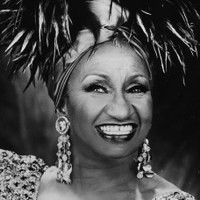Havana (Cuba), 1925 – Miami (EUA), 2003
By Ángel G. Quintero Rivera
The queen of salsa never agreed with the term, as in her way of making music she represented the most traditional tendency, closely tied to Cuban sound, which the Venezuelan analyst César Miguel Rondón called the current of “matancerización,” referring to La Sonora Matancera, Cuba’s main orchestra of the pre-salsa sound, to which Celia Cruz belonged for about fifteen years starting in 1950. For this reason, in the salsa movement, she stood out mainly with Tito Puente’s Orchestra, with whom she produced seven records. Another salsa traditionalist (although an important innovator of Latin jazz), Puente also publicly rejected the term.
At first, Celia planned to be a literature teacher, but after winning a television talent show, she redirected her studies to music. She enrolled in the Havana Conservatory in theory, solfeggio, and piano. With her usual daring defiance, years later she said she had not succeeded at the piano because she liked to show off her long nails. Before her successes with La Sonora, she stood out for her Afro-religious songs; and thus, with Las Mulatas de Fuego, she achieved her first international successes in Mexico and Venezuela. The lead trumpeter of La Sonora, Pedro Knight, was her musical director and artistic manager, as well as her lifelong husband, despite rumors of her secret romances with the “Sonero Maior,” the Puerto Rican Ismael Rivera.
With a powerful contralto voice, her wide operatic range was astonishing, which, combined with her extraordinary rhythmic sense, made her the most prominent female interpreter of “tropical” music in the second half of the 20th century. She also proved to be an excellent sonera. Besides her successes with Puente, she participated in many gold salsa records, among which stand out Celia y Johnny y Tremendo Caché, with the Dominican flutist Johnny Pacheco, and Only They Could Have Made This Album, with the New York Latino trombonist Willie Colón. Shortly before Celia passed away, Emilio Estefan produced her last album, La negra tiene tumbao, which combined salsa with the Miami sound, and for which she received her last Grammy. She had a “queen’s” funeral procession, from York Catholic Cathedral through the main avenues of the “Iron Babel”—a term many Latinos use to designate New York—and Miami.




